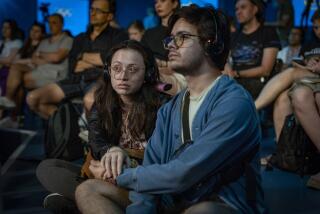100,000 Hold Mass in Ukraine : Rally for Outlawed Church Marks 50th Year of Annexation
- Share via
LVOV, Soviet Union — The outlawed Ukrainian Catholic Church demonstrated its massive power here Sunday as tens of thousands of worshipers knelt on the ground and prayed in an outdoor service and then spilled onto the main avenues, singing hymns and holding lighted candles.
The Mass and a subsequent march to the central cathedral, in which more than 100,000 people took part, was held to mark the 50th anniversary of the Soviet annexation of Western Ukraine.
In a separate demonstration Sunday evening, about 30,000 Ukrainians, many dressed in black, ringed the central square across from the Opera Theater, lit candles and observed 30 minutes of silence in memory of the victims of Soviet dictator Josef Stalin’s repression.
Candles in Windows
Later Sunday night, apartments through Lvov went dark at precisely 10 o’clock as residents in unison switched off their electricity and put candles in their windows.
Hundreds of thousands of Ukrainians were jailed, executed or sent into exile during Stalin’s rule.
In this city where religion and nationalism are intertwined, demonstrators cited dual aims: to demand that Moscow legalize the Eastern-rite Ukrainian Catholic Church and that the citizens be given greater freedom.
The two-hour Mass, held in a central park with worshipers standing shoulder-to-shoulder beneath a canopy of chestnut trees, was for many an emotionally charged event.
“We never expected such a miracle would happen to us,” 67-year-old Maria Laskeuv said with tears in her eyes as the service ended.
‘Had to Pray in Homes’
“For years we had to pray in our homes like mice,” said Laskeuv, who served 11 years in a labor camp from 1944 to 1955 for religious and political activism.
“Now, at last, we are out in the open,” she said.
The service was attended by entire families. People openly wore crosses on their chests, saying “Hallelujah,” and held icons depicting Jesus and Mary. They swayed back and forth, singing and praying. “Freedom for the Catholic Church,” read a sign held by one man.
It was the biggest show of force ever by the Ukrainian Catholic Church in this officially atheistic country.
Ivan Hel, a church activist who spent 18 years in prison for his religious beliefs, estimated the crowd size for the afternoon procession at 150,000 to 200,000.
“But the numbers don’t matter very much,” he said. “This is a moral victory. Look at how powerful our church is. We’ve waited a long time for this, and now our time has come.”
An estimated 4 million believers in the Ukraine are members of the Ukrainian Catholic Church. In the late 1940s, Stalin knew he could not kill religion in the Ukraine entirely, but he repressed the Catholic Church because it looked to Rome for direction.
In 1946, Soviet authorities accused the Catholic Church of widespread collaboration with the Nazis. All the Catholic cathedrals were taken over by the Russian Orthodox Church. Many of those who resisted the changeover were arrested.
“Until just two years ago, believers prayed in homes, in the woods, even in the cemetery, trying to dodge the KGB,” Hel said in an interview.
Although the Ukrainian Catholic Church is still legally banned and thus has no cathedrals, officials over the last two years have tolerated services held outdoors, sometimes even next to churches that were confiscated.
Sunday’s service also was held with permission of local authorities, but only on condition that the speeches and songs be of a religious--and not a nationalist--nature.
Nevertheless, more than 300 yellow and blue Ukrainian flags, once strictly banned as being anti-Soviet, were hoisted above the heads of a wave of people walking to St. Yuri’s Cathedral, and many of the worshipers wore yellow and blue armbands.
“In the past, you could have gotten 25 years for wearing such an armband,” said Peter V. Kohan, 53, who spent two years in exile in Siberia in the 1950s for Ukrainian nationalist activities.
Kohan, a retired teacher, said that although only religious hymns were sung during the march, the radio began playing nationalist songs first thing in the morning, including some that had not been heard on radio since World War II.
“My wife and I both cried,” he said.
About two dozen police officers monitored the worshipers along the three-mile route they followed after the service on their way to St. Yuri’s, the city’s largest Ukrainian-language Russian Orthodox church.
Police also stood guard during the candle-lighting ceremony in the central square. But they were armed only with bullhorns and did not intervene in the demonstration.
Former Leaders Assailed
In the square, flowers were scattered and a poster referred to former Soviet leaders as “despots of the 20th Century who brought the population of the U.S.S.R. to a spiritual, economic, and political crisis.”
Although authorities in the Ukraine have demonstrated increasing tolerance toward religion and nationalism, some protesters gathered in the square contended that repressions continue.
“Just a week ago, two policemen beat me because I raised the Ukrainian flag,” said Orest F. Karelin, a 42-year-old nationalist activist who showed a reporter a cut on his thumb.
Karelin is a member of a radical nationalist group, the Ukrainian Helsinki Assn., which called for outright secession from the Soviet Union.
But spirituality was the main theme of the day’s events.
“We have been struggling for a long time to get our church legalized,” said a 33-year-old factory worker who would give only his first name, Ivan. “This can be considered the peak of our struggle. We want Moscow to acknowledge our right to pray in our own way, in our own churches, without fear.”
More to Read
Sign up for Essential California
The most important California stories and recommendations in your inbox every morning.
You may occasionally receive promotional content from the Los Angeles Times.










